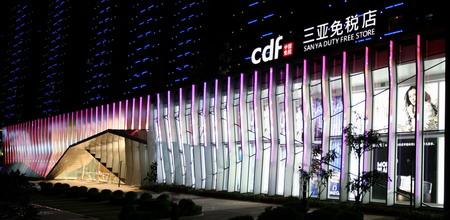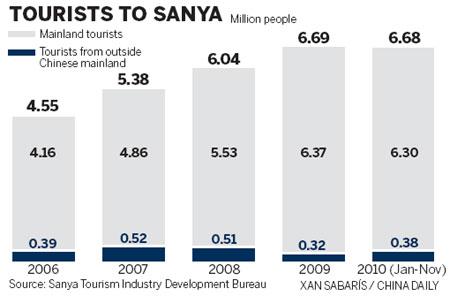
The Sanya duty-free store run by the State-owned China Duty-Free Group Co Ltd (CDF) in downtown Sanya, in South China's Hainan province. Mainland visitors are expected to be allowed under a new government policy to buy tax-free goods at CDF stores on the island next year, although only overseas passport holders and residents of Taiwan and Hong Kong can do so now. [Photo / Provided to China Daily]
Hainan set to allow visitors from the Chinese mainland to buy duty-free goods from next yearSANYA, Hainan - Mainland people are set to lose out from a new tax-return policy to be unveiled during an official news conference on Monday that will further benefit foreign travelers and visitors from Taiwan, Hong Kong and Macao to Hainan province.
Even though the State Council gave the nod to the province to explore the possibility of allowing domestic tourists outside Hainan to enjoy duty-free shopping earlier this year, visitors from the mainland are still excluded while others are enjoying a bonanza.
Despite their hopes and expectations, mainlanders need to wait for "another half year or so"for the full implementation of the duty-free policy, according to Guo Zhiming, a division director of the publicity department of Hainan provincial government.
"Starting from the beginning of next month, overseas travelers (including those from Taiwan, Hong Kong and Macao) can reclaim the tax they paid for 21 categories of goods in three designated Sanya and Haikou shopping malls when they leave the province. That's something new apart from the duty-free shopping they already enjoy," said Guo. "However, mainland people would need to wait until next May or later."
"They just wouldn't let me buy anything," said Huang Ruixi, a 22-year-old luxury brands buyer from Suzhou. It was Huang's last day of a brief tour to Sanya and she was disappointed in the city's downtown duty-free store.
'Be patient'
"I was told that only foreign passport holders or those with Hong Kong or Taiwan passport could buy duty-free goods here. They need to show a ticket for a flight departing from Sanya as well," said Huang. "It makes no sense to just have a browse - the majority of potential customers here are Chinese, and they are not allowed to buy."
A member of staff surnamed Ke, who works at the store's luxury watch booth, said: "We receive many daily inquiries from domestic shoppers, but the only thing we can tell them at the moment is to be patient. The chances are they will be eligible to purchase next year. We've been waiting for that moment to come as badly as they have."
With only a few foreign shoppers milling about, the 7,000-square-meter (sq m) Sanya Downtown Duty-Free Store is nothing close to a popular destination. There is a tag placed in every booth of this two-story shopping mall to remind mainlanders who is eligible to purchase.
"Our product prices are on average 15 to 35 percent lower than those in the city's major shops, depending upon in which categories they fall. They're almost equal to a similar store in Hong Kong," said Xu Lina, the marketing and overseas agent sales manager of Sanya Downtown Duty Free Store Co Ltd, which belongs to the only Stated-owned duty-free group in China - China Duty Free Group Co Ltd (CDF).
The downtown store looks no different from most of its overseas peers and sells a range of imported goods such as leather bags, accessories and watches. US dollars, Japanese yen, Hong Kong dollars and euros are accepted at the shop with spot exchange rates.
"Cosmetics and perfumes are still the mainstays, but we added men's outfits and watches in March. Big luxury names including Tiffany and Cartier also arrived this September," said Xu.
"In total, we have around 80 to 90 high-end and medium-end international fashion brands available. But it's still not the final figure - new brands are coming in."
Japanese hair-care and cosmetics producer Shiseido Co Ltd opened a counter at Sanya's downtown duty-free store this March.
The fourth-largest cosmetics company in the world by sales volume said it had faith in the potential for Hainan's duty-free zone, even though the new policy might only apply to China's domestic customers starting from next year.
No date has yet been confirmed.
"The way we worked with Hainan's CDF is exactly like what we're doing with South Korea's Jeju Island and Japan's Okinawa," said the source from Shiseido's headquarters in Japan, who preferred to remain anonymous.
"There (in Jeju and Okinawa), Japanese and Koreans are eligible to purchase duty-free products and I think domestic travelers from the mainland will enjoy the same in Hainan soon."
Knowing that more than 96 percent of Sanya's tourists are Chinese and pinning its hopes on the upcoming duty-free policy, CDF invested in another 250,000 sq m shopping area in Haitang Bay, 30 kilometers to the east of Sanya, in addition to its downtown duty-free store.
"The concept is different over there," said Xu. "With a venue of 250,000 sq m, it's going to be an integrated project with not only duty-free shops, but also restaurants and other entertainment facilities. Farrel Yi from Taiwan spent more than two years working in Sanya. Despite the advantage given by her home province, she still found the duty-free experience to be not as convenient as she expected.
"The thing is I can't pick up what I paid for in the shop," said Yi. "I can only receive them at the boarding gate of the airport."
This will not be a problem for her from Jan 1, according to the new tax-return policy. "It will be possible to buy 21 categories of goods, including leather and cosmetics, at Sanya's Summer Mall, Haikou's Shengsheng Department Store and the No 1 Department Store at their full price for direct pick-up. Any taxes due can be claimed back when tourists leave Hainan," said local official Guo.
An executive from CDF's marketing team, who preferred to remain anonymous, said there would be two ways of tax-free shopping in China by then.
"Duty-free and tax-return," he said. "You can either purchase duty-free goods from CDF or pay the full price and reclaim the tax in these department stores."
The concept of duty-free shopping is relatively new to the Chinese and more often encountered abroad. Europeans and Americans are familiar with picking their shopping up at the airport. The Chinese are more used to cash-and-carry. "Still, they worry not only about fraud but also about the risk of their goods breaking on the way to the airport," said the executive from CDF's marketing team.

New duty-free policy
According to him, the only reason duty-free goods need to be picked up at the airport is to protect products that are not duty-free. "Think about it. If the same product has different price tags in the same shop, what would happen to the ones that are not duty-free? We're doing what overseas duty-free shops do. It's an international convention." Duty-free commodities are exempted from import duty, import linkage excise tax and import linkage value-added tax. They are not only available at airports, but also on flights, at borders, on ocean-bound ships, at ferry terminals, at railway stations and in downtown duty-free shops.
CDF is the only State-owned enterprise specializing in the duty-free business. It was established in 1984 and now has more than 200 outlets in 29 provinces, municipalities and autonomous regions in China.
The difference between duty-free shops in Hainan and Jeju Island in South Korea, according to Zhou Jun, a spokeswoman for Korea Tourism Organization's Shanghai office, is that the former are State-owned enterprises and the latter are managed by private companies in a relatively free market.
"There is no such a thing as 'the only duty-free company' in Jeju, and two of the biggest ones are Lotte and Shilla, both privately-owned. The fact that the market is rather flexible benefits travelers coming here and improves our service," said Zhou.
"To take a simple example, duty-free shops in the island extend their opening hours specially for travelers on cruise ships from 8:30 pm to 10 pm, simply because they have the biggest spending power."
According to the commerce department of Hainan provincial government, all duty-free outlets, whether already open or yet to be opened in the province, have to be run by CDF.
"We'd like to attract both domestic and foreign investors if possible so that the service and competitive power of the industry are guaranteed," said a spokesperson for the department, who declined to give his name.
In its defense, CDF said enjoying duty-free status was a concession by the State and if it was not controlled by a State-owned company, nobody could assure customers about the discount.
Tourists to Hainan

No matter who ultimately benefits, Hainan's tourist market is bound to grow. Hainan is expected to become a global tropical island resort destination by 2020, and the tourism industry is expected to contribute 12 percent of Hainan's gross domestic product by then.
The major local airline, Hainan Airlines, increased by 25 percent the number of its domestic flights going to Sanya from this summer to winter. "Now we have around 84 flights heading to Sanya from all around China every week," said Tan Hui, spokesman for Hainan Airlines.
"New routes from Urumqi, Lanzhou, Changsha and Wuhan (to Sanya) are expected in the future," he said. "Some of them will have an in-flight duty-free service."





